Behind The Lens: Rolex GMT-Master II Meteorite, Where Global Travel Meets Outer Space
by GaryG
There’s just something about astronomical complications! For me, the fascination of timekeeping is closely linked with the idea of mindfulness – whether that’s the “memento mori” awareness that our time in this world is finite or the “we inhabit a small rock circling a flaming ball of gas in the midst of a near-infinite void” reminder that astronomical timepieces provide.
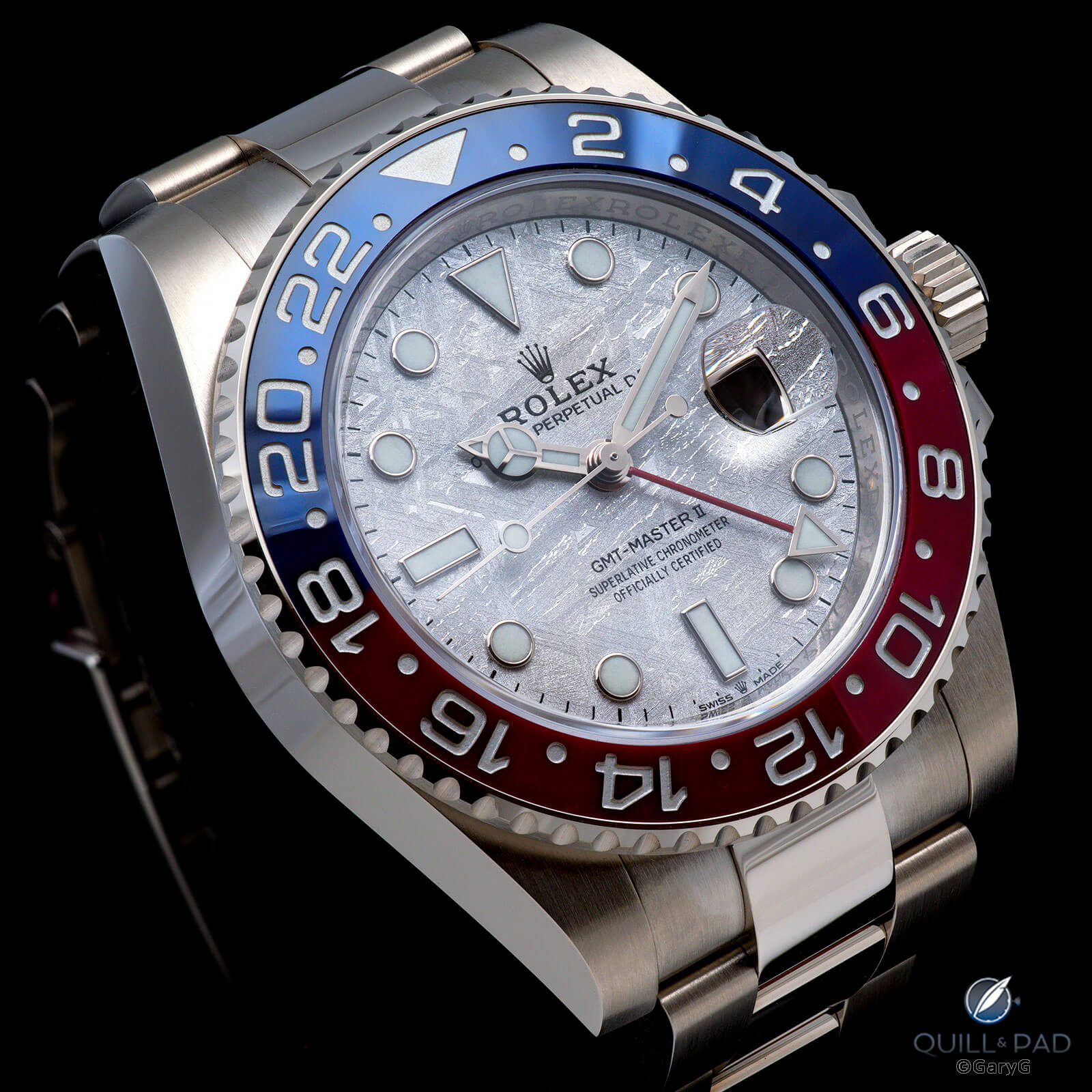
From space to your wrist: Rolex GMT-Master II BLRO Meteorite
For instance, an early purchase still in my collection is Audemars Piguet’s Jules Audemars Equation of Time with its perpetual calendar, moon phase, equation of time indicator, and times of sunrise and sunset in my home location.
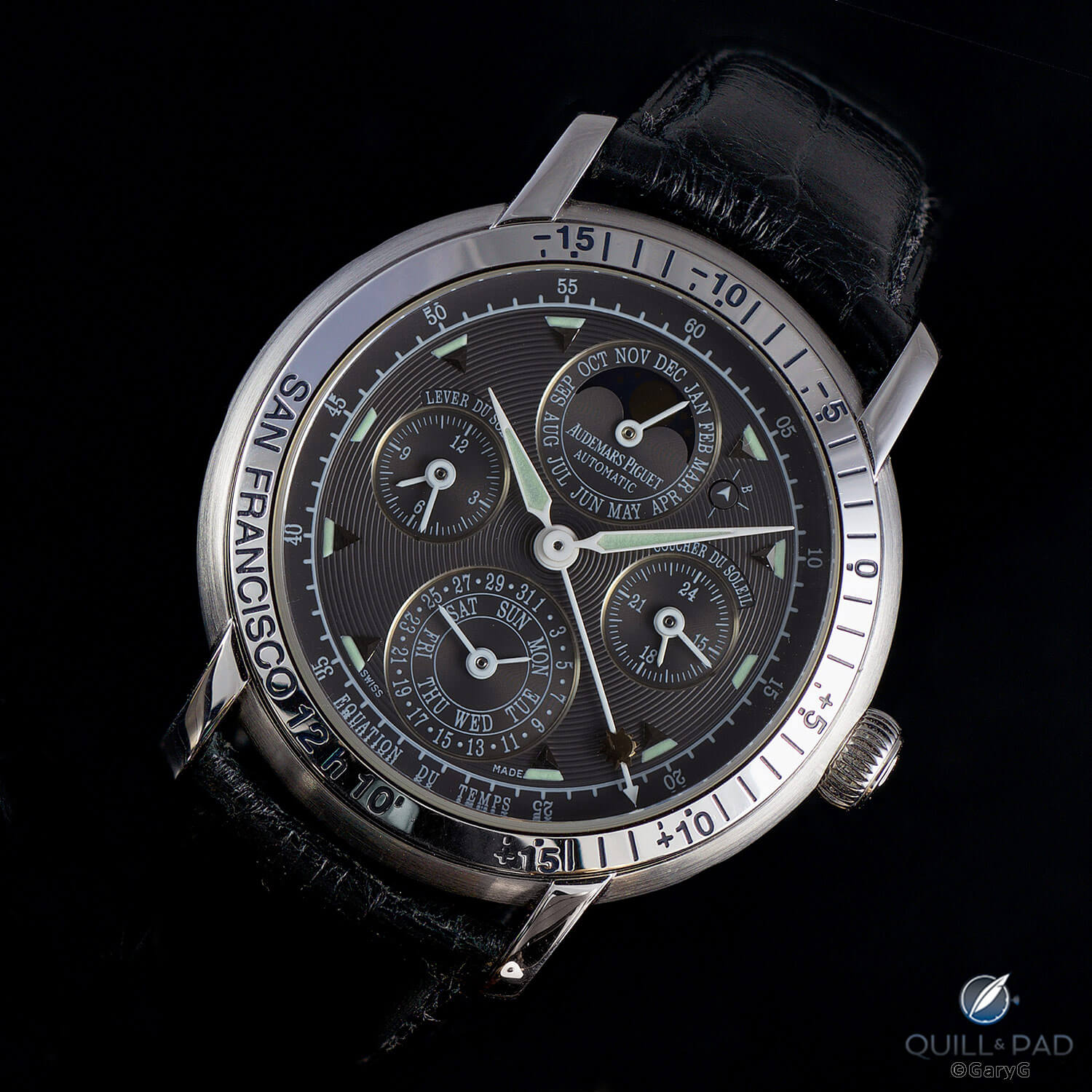
Lost in space: Audemars Piguet Jules Audemars Equation of Time
Anytime I wear that watch, the earth’s tilt and elliptical orbit become a bit more real to me. And when I look at watches new and old, my attention sharpens when I see anything from the wonderful moon phase of the Hermès Arceau L’Heure de la Lune to Ulysse Nardin’s wildly complicated Tellurium, Planetarium, and Astrolabium trilogy to Konstantin Chaykin’s Mars Conqueror with its displays of time on both earth and Mars.
Down here on earth, there’s also the need to know the current time in distant locations, whether that’s helping pilots to see the time at their destination at a glance, figuring out the hour in Geneva for an upcoming conference call, or monitoring home time while on the road to avoid awakening family members with an ill-timed phone call.
I’m not a pilot, but the latter two requirements do apply to me and over the years I’ve accumulated a variety of GMT and travel time watches, including a Rolex GMT-Master II BLNR “Batman.”
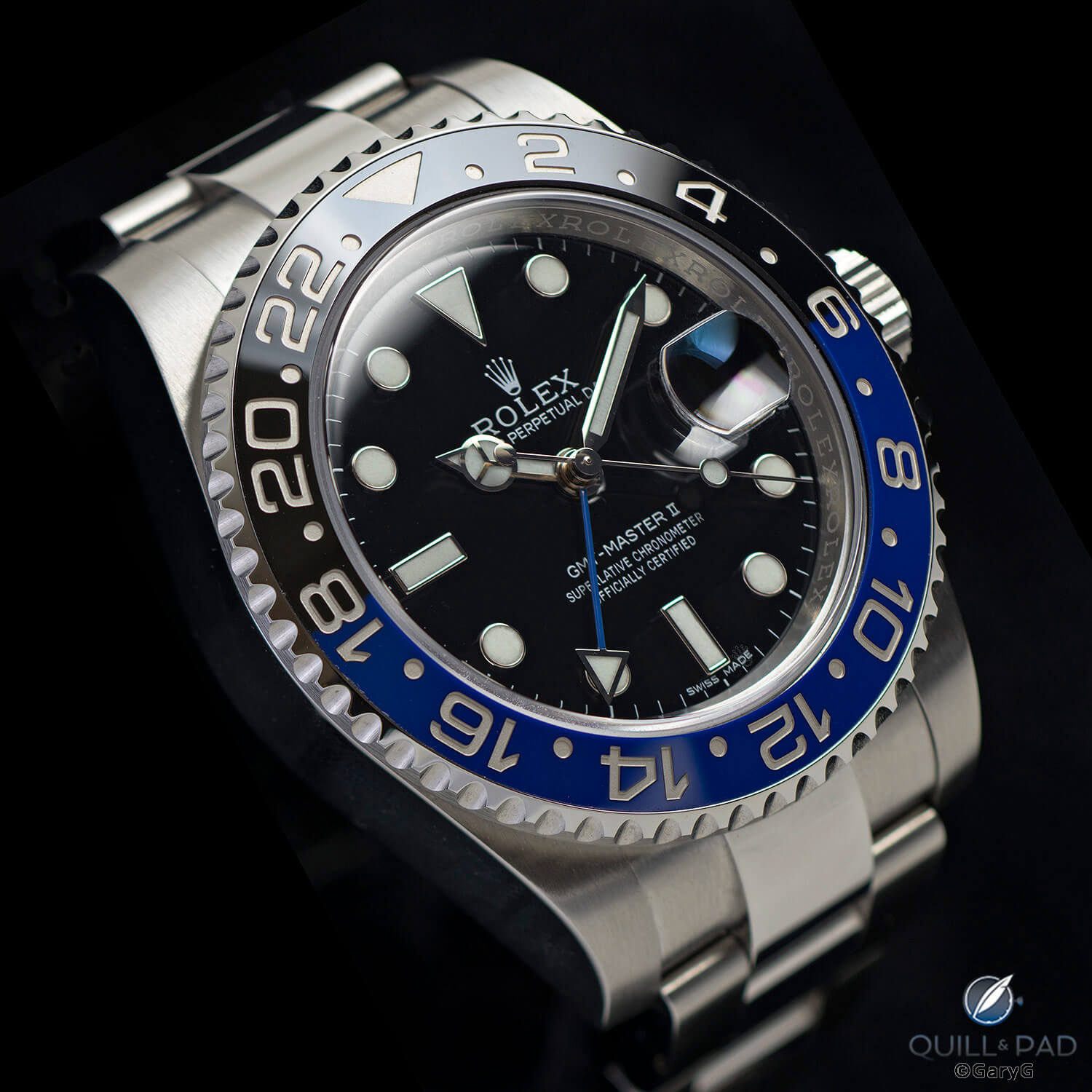
Spanning the globe: Rolex GMT-Master II “Batman”
But what if our and other worlds – figurative and literal – collided to give us a watch that brought terrestrial travel and a real touch of outer space to the same small space on the wrist?
Recently, I had the opportunity to find out when a long-time friend handed over his Rolex GMT-Master II BLRO Meteorite for me to inspect, photograph, and wear.
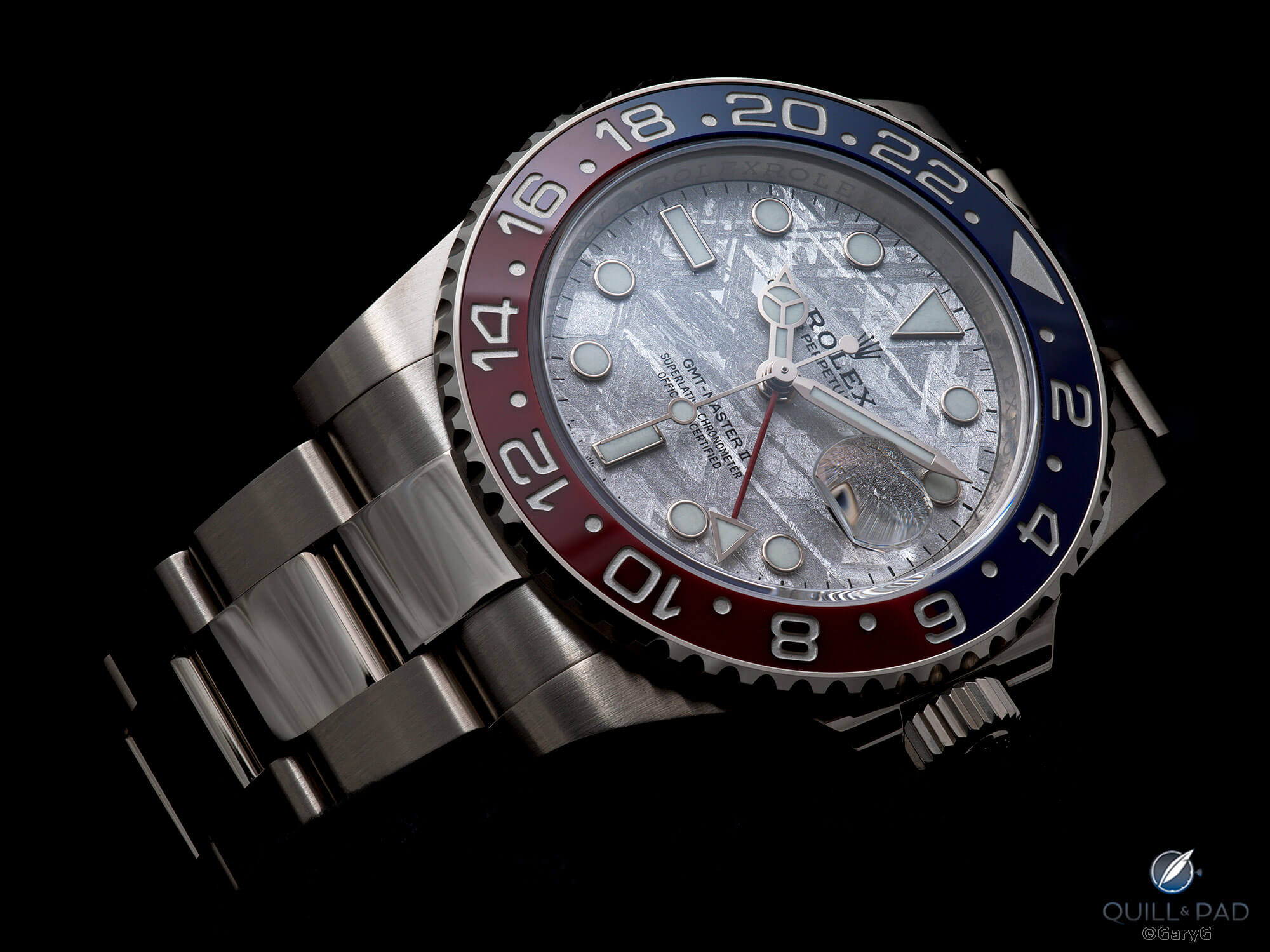
When worlds collide: Rolex GMT-Master II in white gold with meteorite dial
Skipping the history of the Rolex GMT-Master
If you follow watches you’ve no doubt read a zillion histories of the Rolex GMT-Master and its origins, so I’ll spare you that here other than to note that the first-generation Reference 6542 with its ever-so-fragile Bakelite bezel continues to exert a pull on me – and that my desire for one will almost certainly remain unrequited as long as prices for minty versions remain in the ionosphere.
Let’s focus on the piece at hand! The immediate impression that strikes upon picking up the BLRO Meteorite for inspection is its serious heft; there has been no skimping on the construction of the white gold case and bracelet. And as a fan of substantial watches, I really appreciate the mass of this piece.
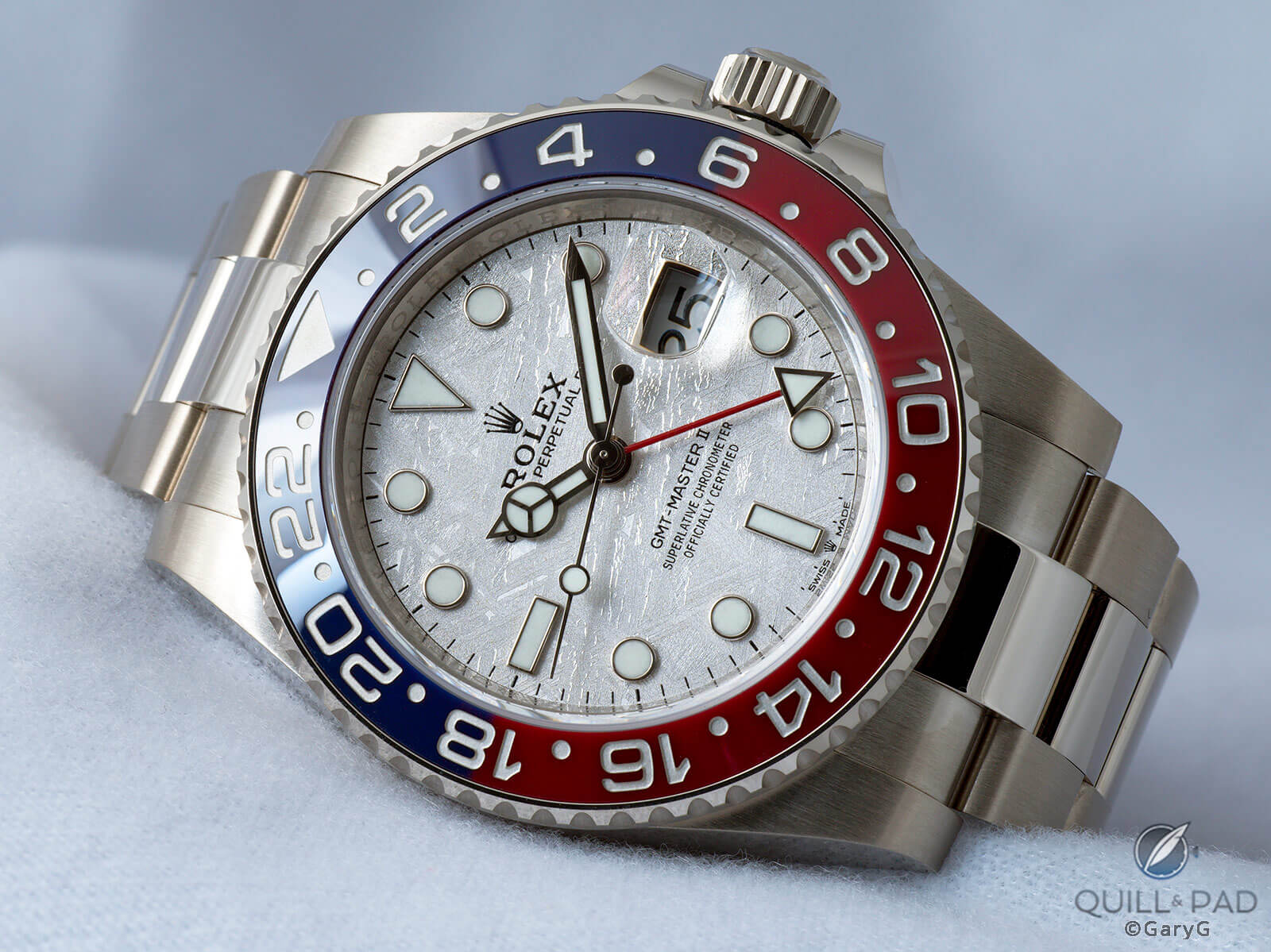
White gold through and through: Rolex GMT-Master II Meteorite
As shown in the image above, the case and bracelet color also clearly signal this as a white gold watch. Rolex does not rhodium plate its white gold pieces, and while the brand does use a proprietary alloy rich in bright palladium, the resulting hue still has a pleasant hint of gold tones.
While on the topic of case and bracelet, I’ll note that I’m a fan of the current incarnation of the Oyster bracelet as used on the GMT-Master. It’s comfortable on the wrist, the rounded edges of the links smooth the view as the bracelet drops away around the wrist, and the balance of brushed and polished surfaces seems just right.
I also appreciate the Oysterlock safety on the GMT-Master’s clasp and only wish that it were a feature of the bracelet of my recently acquired Oyster Perpetual 41.
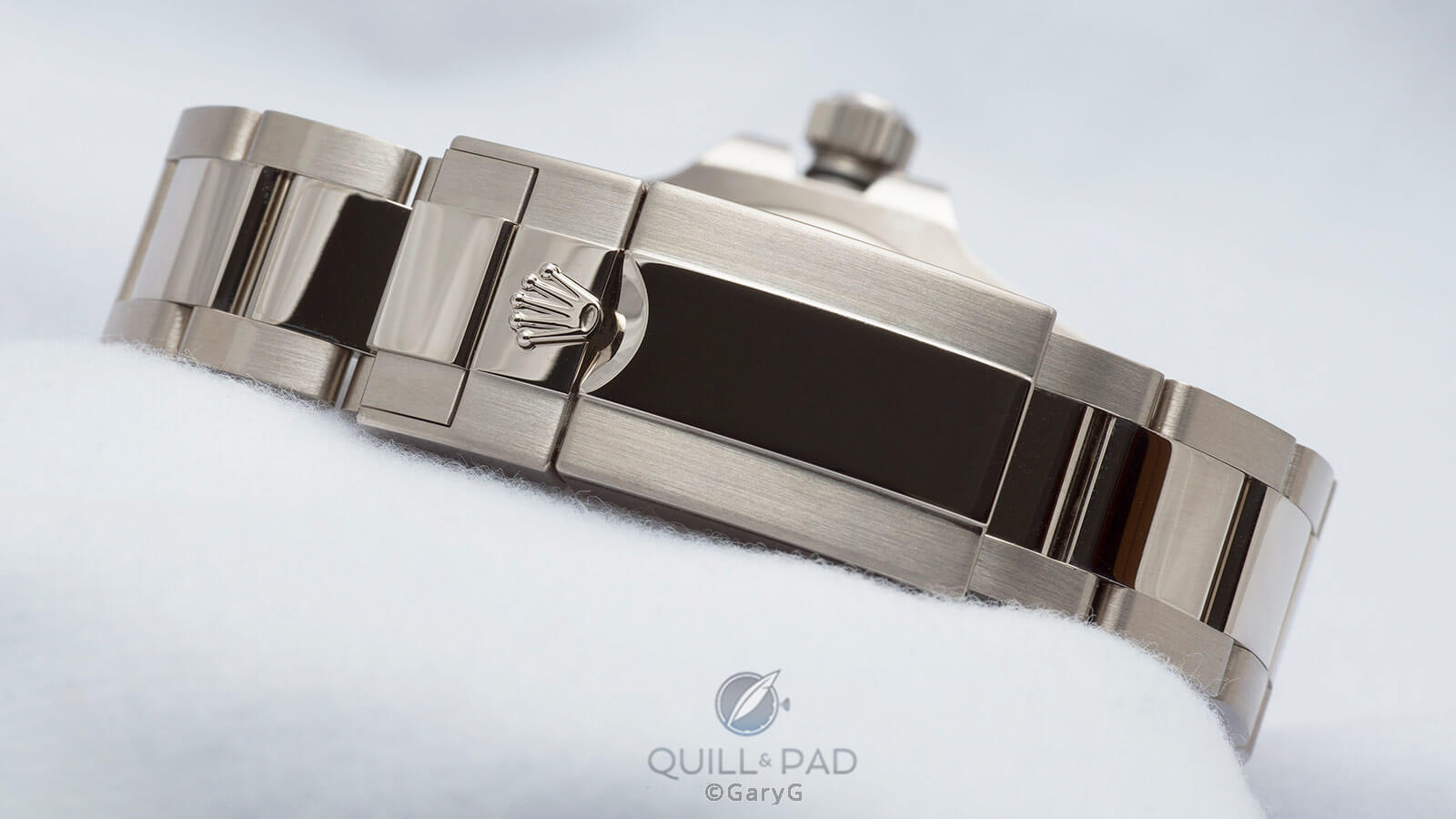
Bracelet detail, Rolex GMT-Master II Meteorite in white gold
The main event though is the dial itself: a thin slice of metallic meteorite whose crystalline structure reflects the slow cooling process that took place as the meteor hurtled through space and whose contrasts have been made more vivid both through careful orientation of the slices made through the meteorite and by chemical etching processes.
As with most photos you’ll see of Rolex meteorite dials, the orientation of the primary patterns on this dial travel upward from left to right, I’m assuming as the result of a considered design decision.
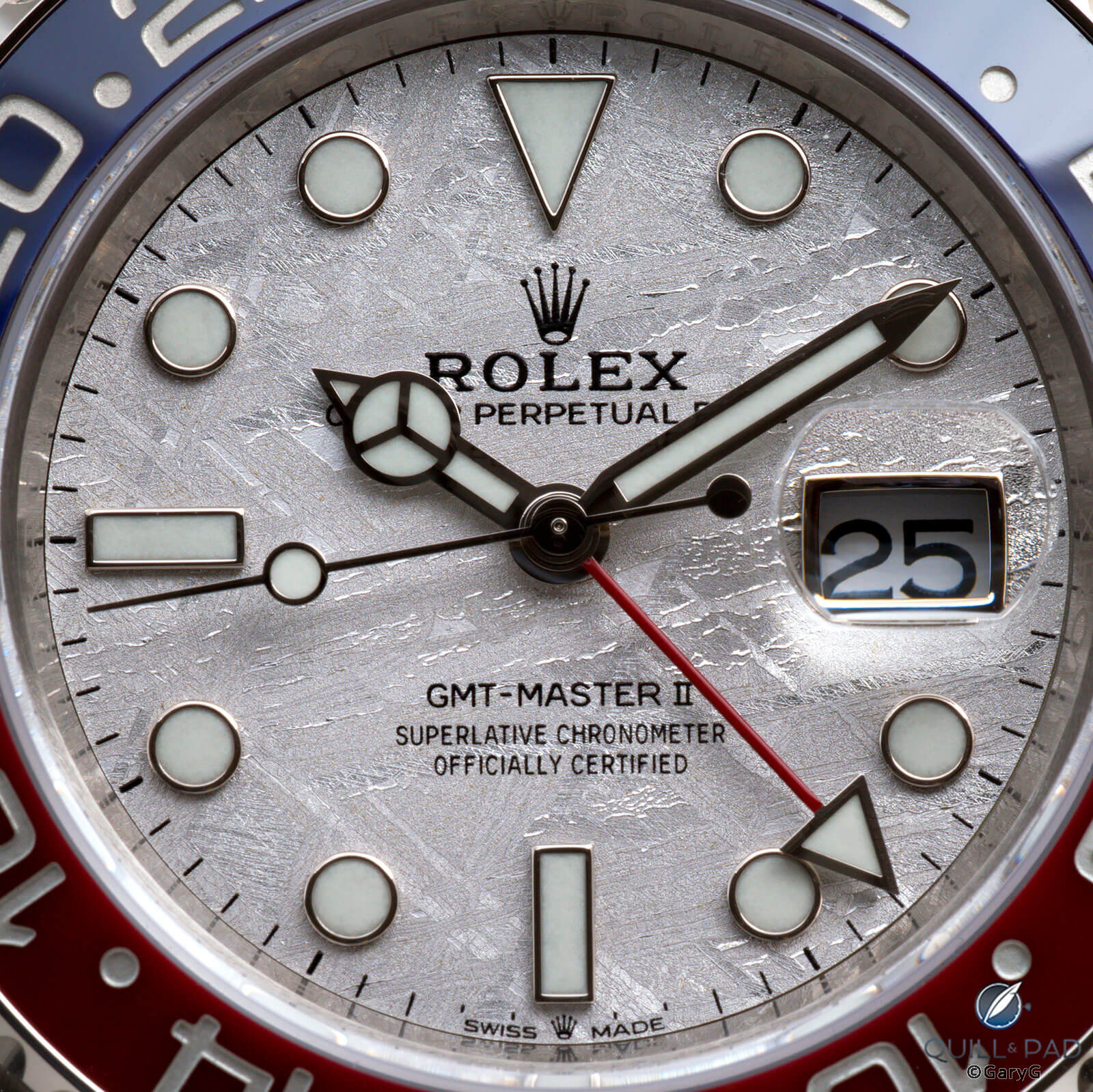
Dial detail, Rolex GMT-Master II BLRO Meteorite
For the image below, I took the watch out of the light tent and exposed it directly to the flash gun at an oblique angle, both to reveal as much of the texture as possible and to highlight just how metallic this dial can look in certain light conditions.
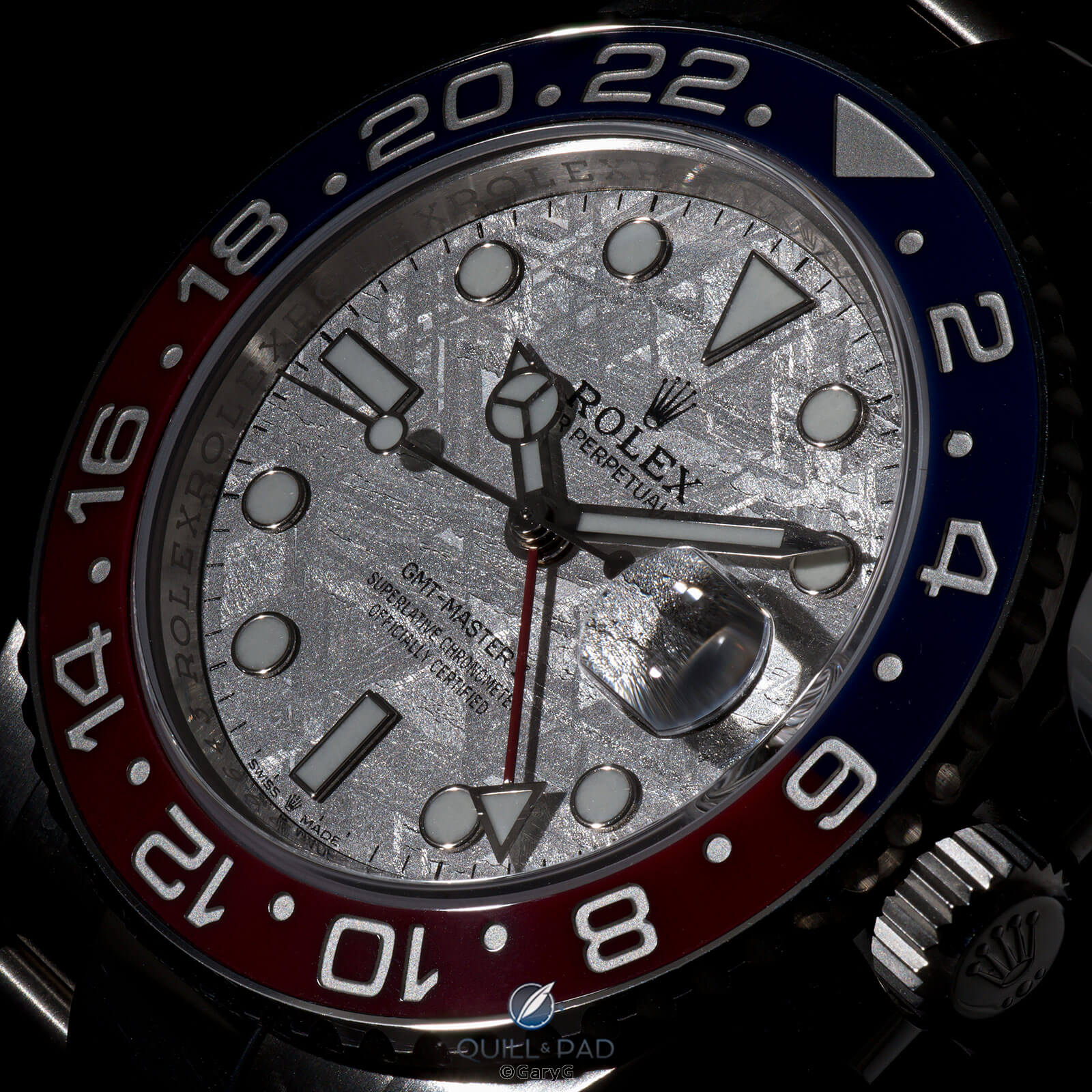
High-contrast view of the Rolex GMT-Master II’s meteorite dial in direct light
While I wasn’t at all shocked that the meteorite material took on different identities under different light, I was a bit surprised that positioning the watch at assorted angles didn’t make that big a difference.
I’m not sure what I was expecting, but in the low-angle shot below the dial neither pops in a different way nor reveals hidden depth (at least to my eye) that we don’t see in straight-on views of the watch.
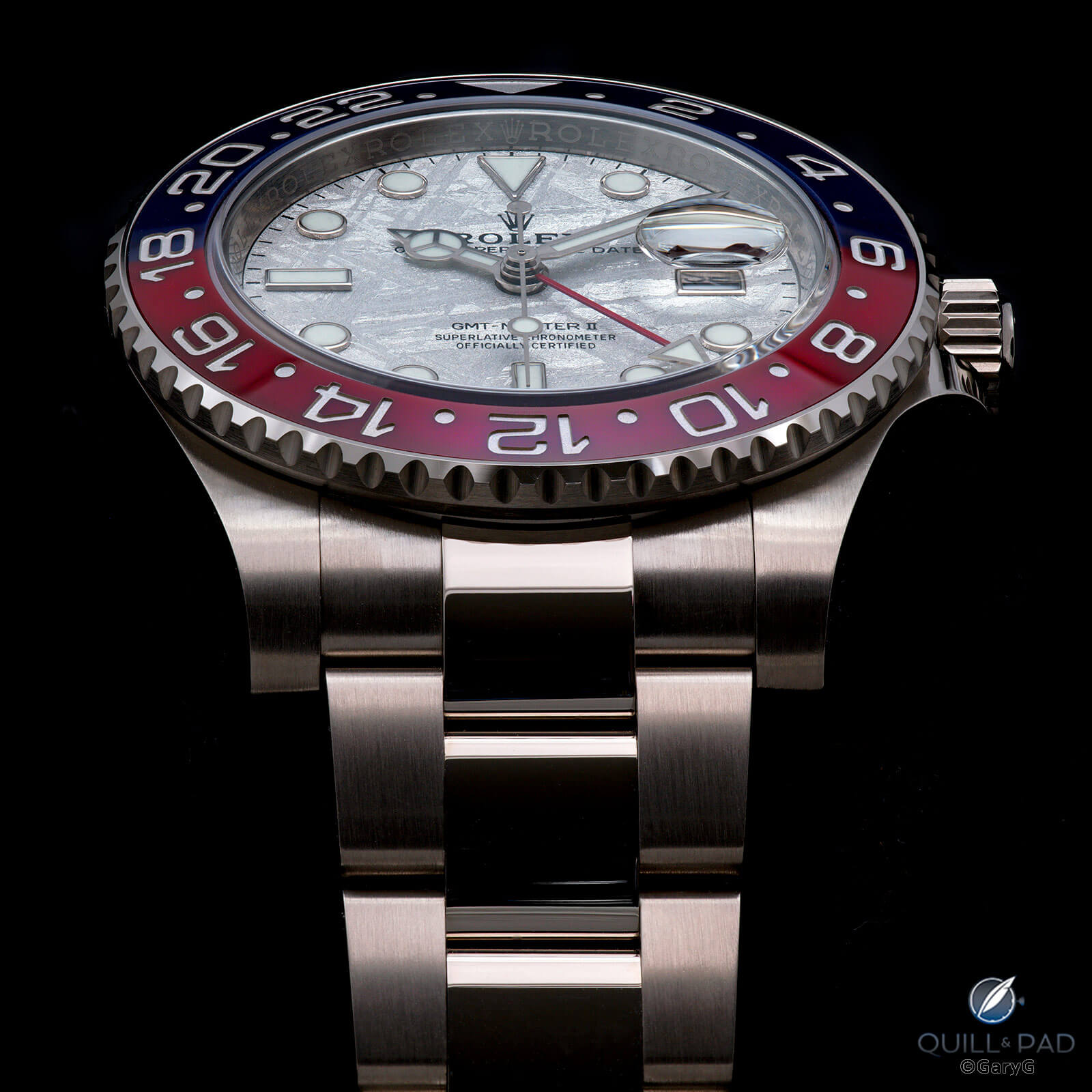
Low angle view, Rolex GMT-Master II Meteorite in white gold
Rolex GMT-Master II on the wrist in changing light
Shooting watches in formal, static setups is both fascinating (at least to me) and fun, but some watches just don’t seem to come to life until they’re seen on the wrist in the same way that there are some pieces that only shine once they are out of the display case at the dealer – and sometimes outside the building.
For me, the GMT-Master II Meteorite is one of those watches. While I found the monochromatic stretch of meteor material against the white gold backdrop just a bit flat in the light tent, even with the interceding blue-red bezel, the same combination somehow seemed just right once clothing colors and skin tones came into the equation.
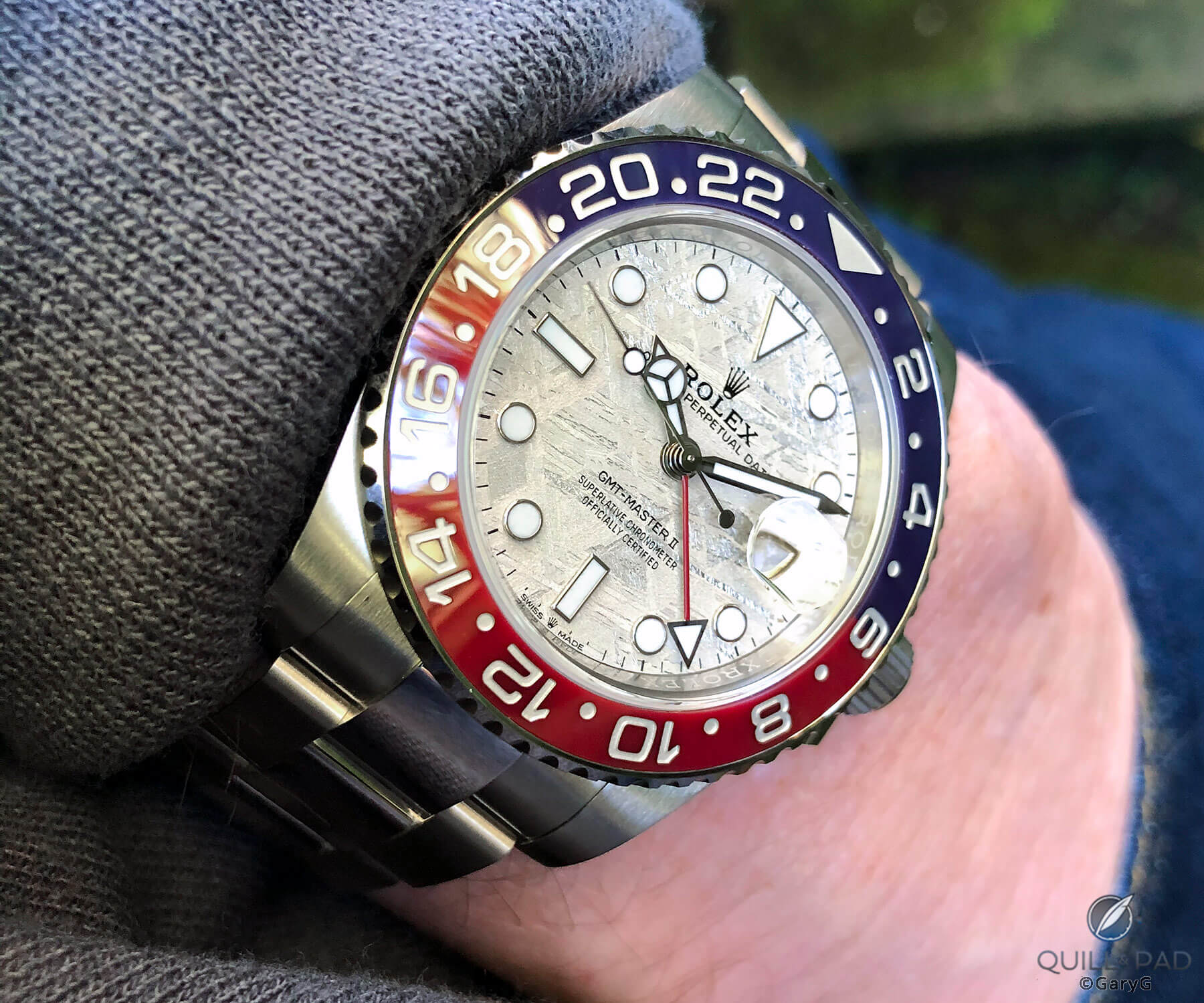
Space grey meets color: Rolex GMT-Master II Meteorite on the wrist in natural light
There’s a reason why Buzz Aldrin described the moon’s surface with the term “magnificent desolation.” For this watch, bringing the cold hue of a space rock into a colorful earthly context seemed to work to the benefit of both.
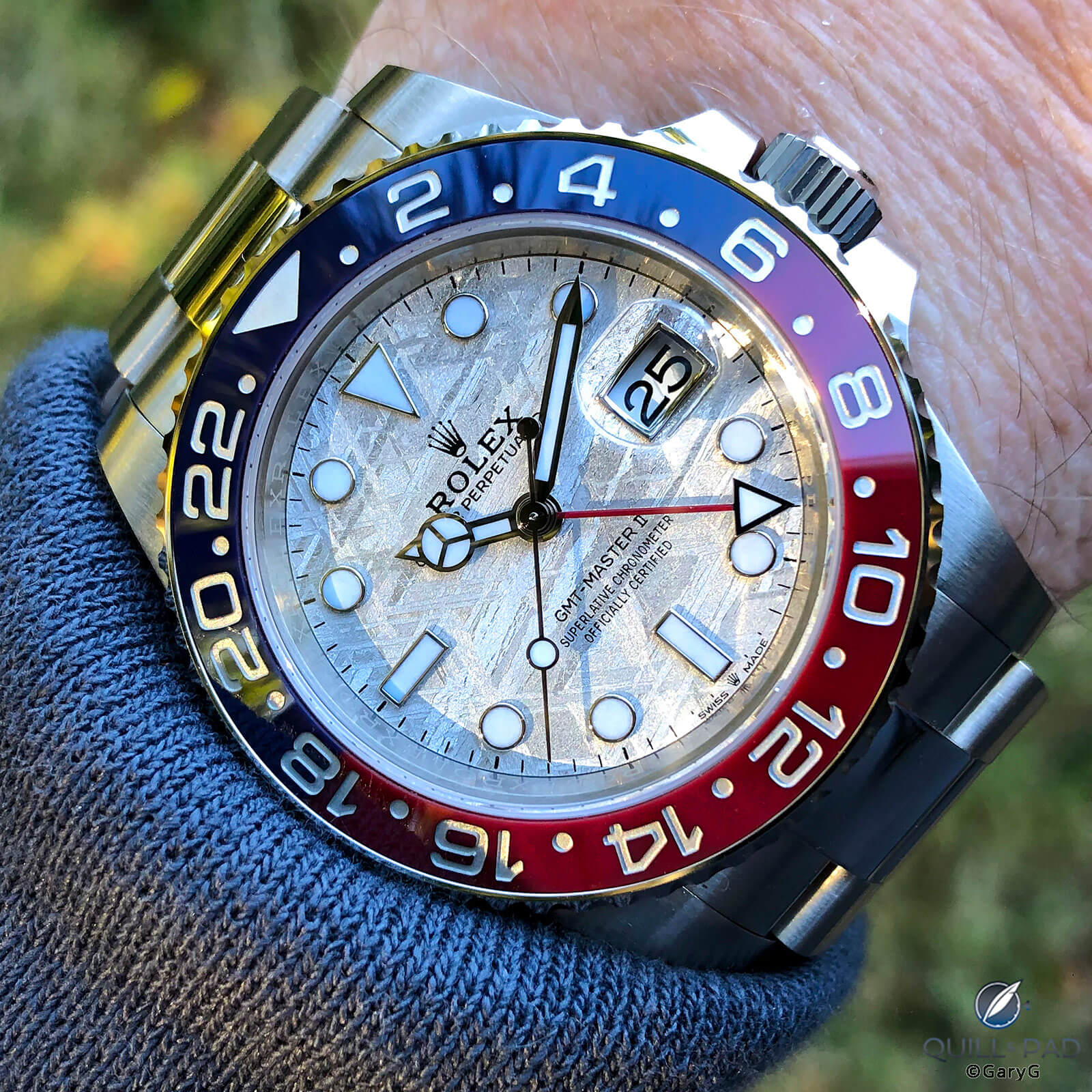
Dappled sunlight and the Rolex GMT-Master II Meteorite
Dappled afternoon sunlight in the garden served both to emphasize the tones and patterns of the dial and to give some added life to the vivid red and blue of the Cerachrom bezel. While overall I’m a fan of the black-and-blue Batman look over the “Pepsi” GMTs, in this instance I don’t think the more subdued BLNR bezel would do the trick.
If you don’t believe me, do a quick online search for the Frankenwatch Batman with meteorite service dial.
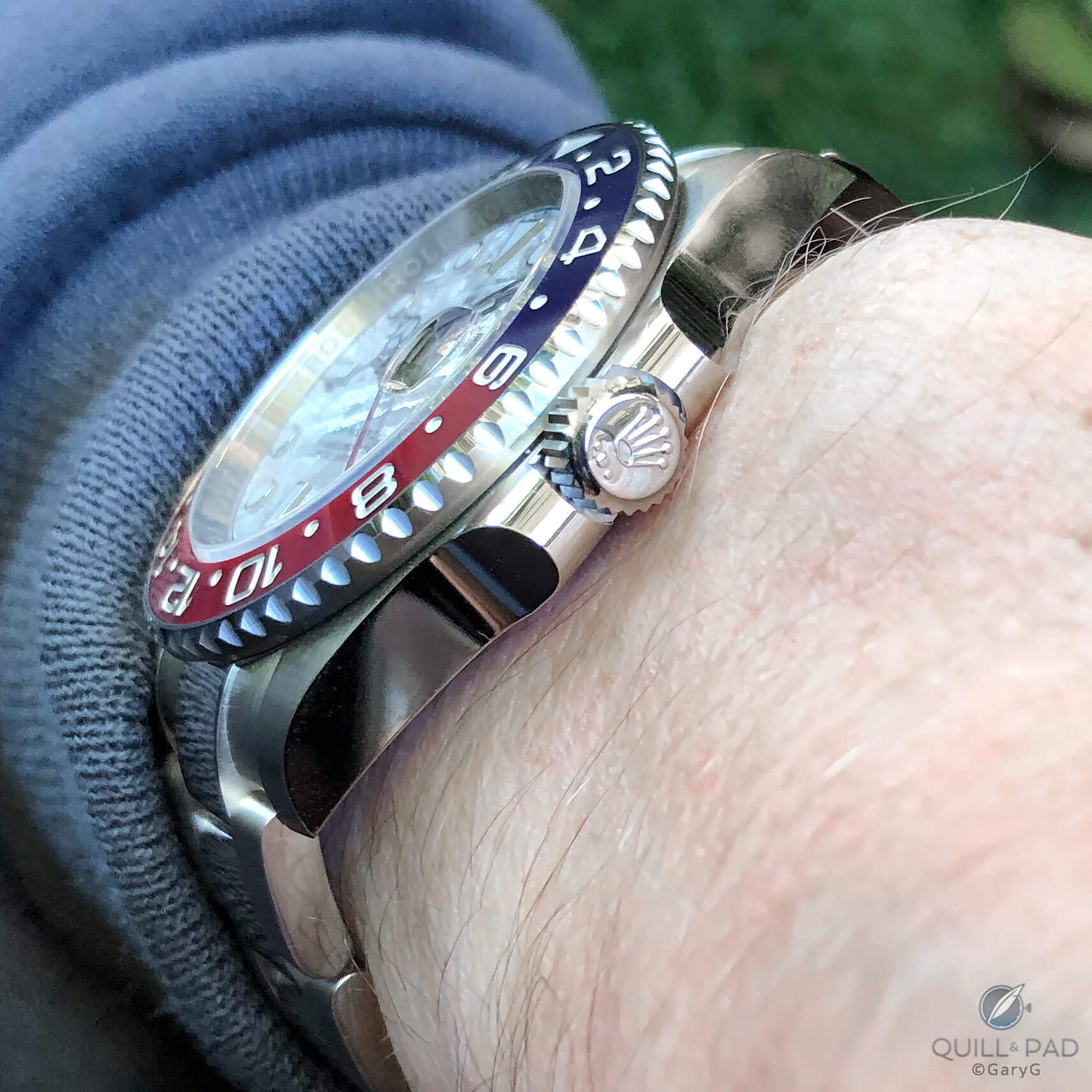
Edge view, Rolex GMT-Master II Meteorite
While I was at it, I grabbed a quick on-wrist shot of the edge of the watch and how it sits on the wrist. You either like the sharp edges and slab-like sides of the current GMT-Master design or you don’t; for me the appeal of this view is how the light makes the brighter crystalline structures of the dial stand out.
Back indoors for a lume check, and as you might expect the blue Chromalight on the indices and hands did not disappoint.
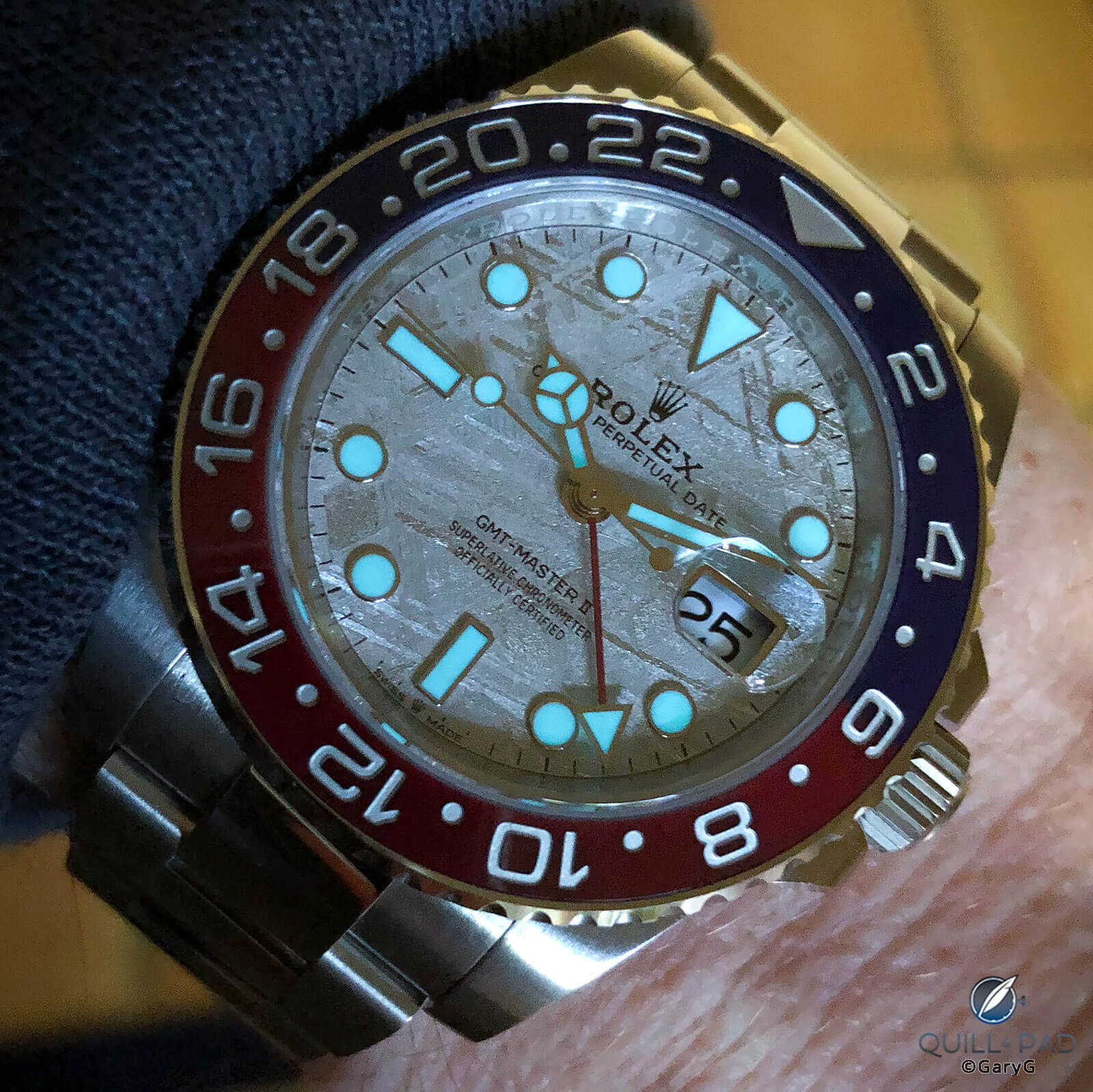
Residual luminosity after a quick jaunt outdoors, Rolex GMT-Master II
And in a darkened room after a quick blast from a UV light, the luminous glow is almost too bright (is there such a thing?) and, even better, gives one more perspective on the shapes and tones of the meteorite dial – what one might see out the window of a spaceship during a close rendezvous with a meteor if members of the Rolex marketing team had been up there first to paint on the logo and install a cyclops.
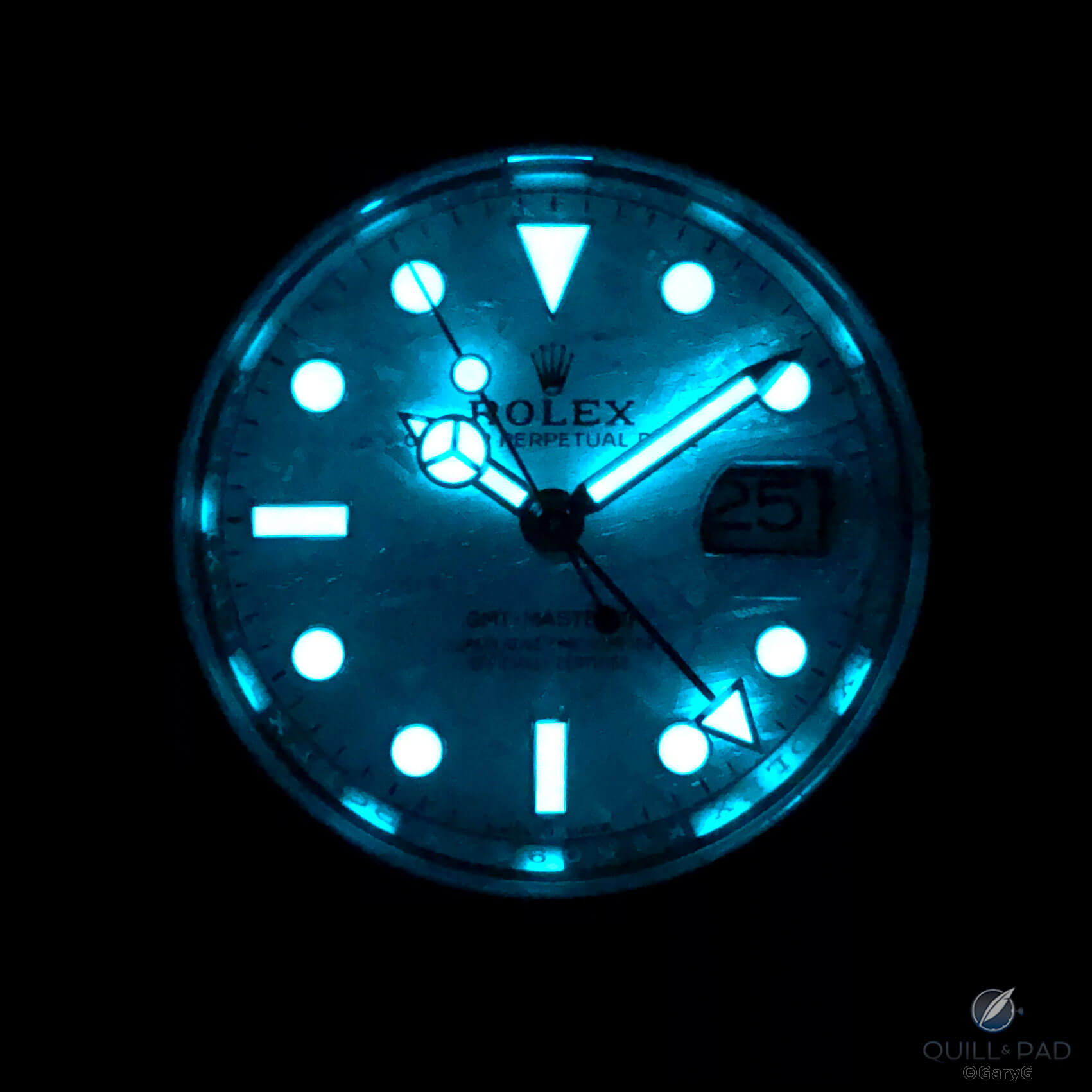
Chromalight illumination of the Rolex GMT-Master II’s meteorite dial
In the tent one more time
One nice thing about having watches on loan from friends is that they are often in less of a rush to have the watches returned than manufacturers who have perhaps a few examples of a highly in-demand introduction to share with multitudes of eager reviewers.
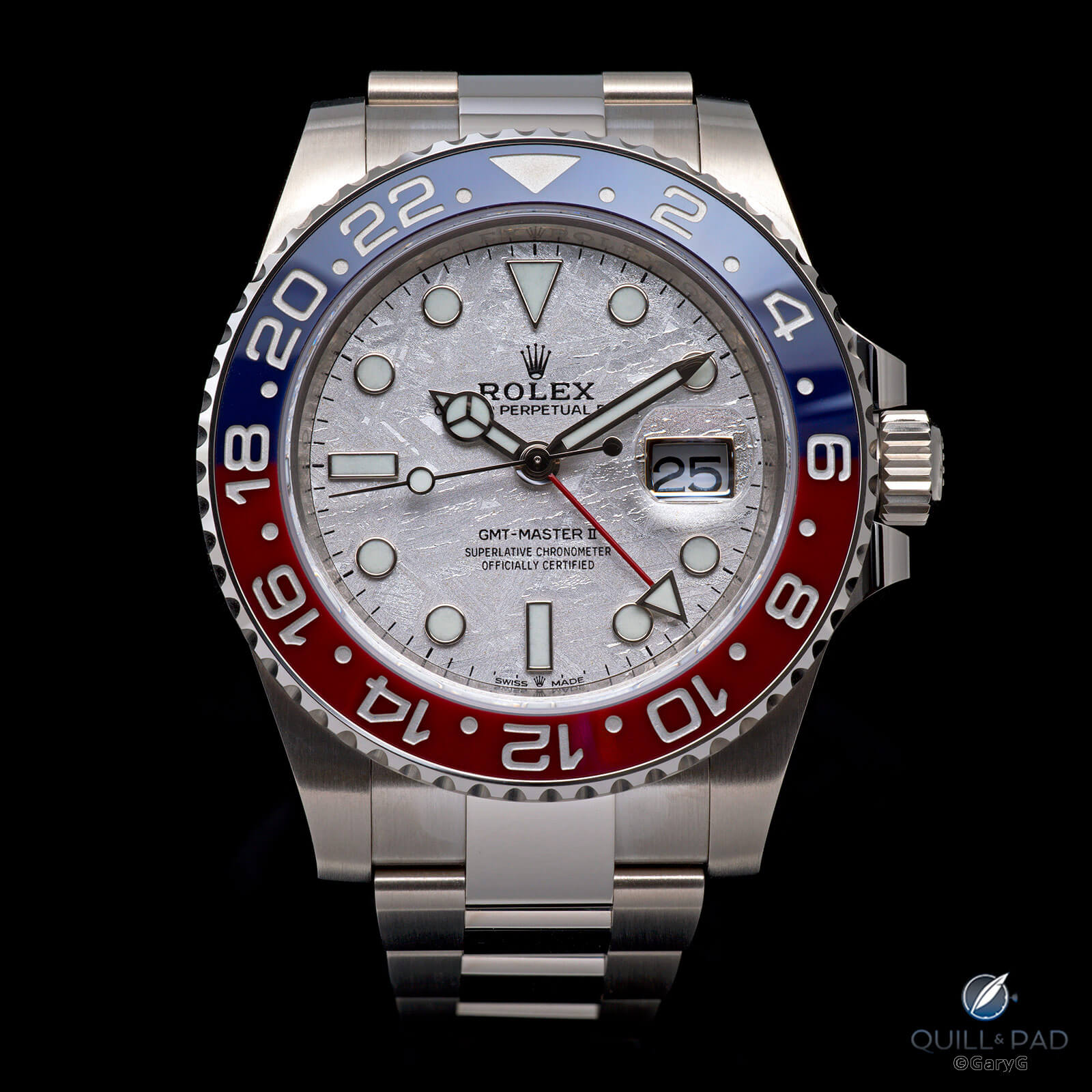
Straight-ahead view, Rolex GMT-Master II Meteorite
After I have the chance to let the first set of processed images sit for a few days, I circle back and (after shaking my head and discarding a bunch) try additional setups or retry positions that didn’t quite pan out the first time around.
As an amateur I have the luxury to do this, and while some of the results invariably strongly resemble one or more of the initial shots, I do usually create a few perspectives that I hadn’t captured before.
And while I make a practice of expanding my repertoire of shooting styles and techniques, I do always try to go back to my signature “moody” style at least a bit as I suspect I’ll always be a fan of the chiaroscuro look when it comes to photographing watches.
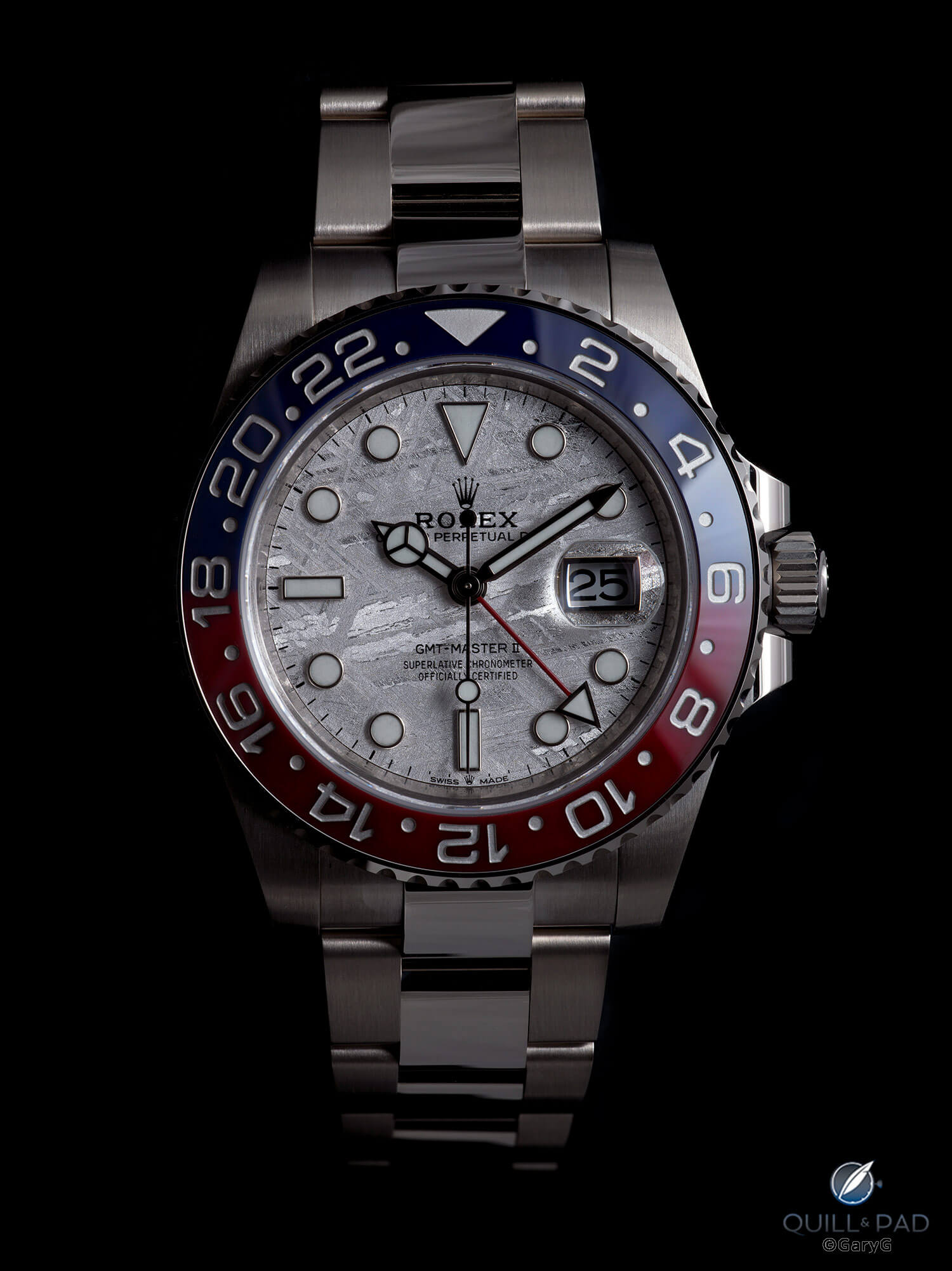
Parting shot: Chiaroscuro style and the Meteorite
I’ll confess that this watch presented some challenges to making compelling images until I began modifying my approach, but found that by using some relatively dramatic variations in light and going beyond formal settings, the personality of the piece gradually emerged.
I’ll look for your thoughts on how you bring out the essence of watches, particularly tricky-to-capture ones, in the comments below. In the meantime, happy shooting and happy wearing!
Quick Facts Rolex GMT-Master II Reference 126719BLRO
Case: 40 mm, white gold case; monobloc middle with screw-down case back and Triplock winding crown; bidirectional rotating 24-hour bezel with blue and red Cerachrom insert; sapphire crystal with cyclops lens
Bracelet: white gold Oyster bracelet with Oysterlock safety clasp and 5 mm Easylink extension
Dial: meteorite dial with blue Chromalight luminous markers and hands
Movement: automatic Caliber 3285, 28,800 vph/4Hz frequency; power reserve 70 hours; rated to -2/+2 seconds per day after casing (C.O.S.C. chronometer certification plus Rolex certification)
Functions: hours, minutes, (hacking) seconds; date; second 24-hour time zone with independent rapid-setting hour hand
Price: $38,400
* This article was first published on February 27, 2021 at Behind The Lens: Rolex GMT-Master II Meteorite, Where Global Travel Meets Outer Space.
You may also enjoy:
All 7 Of The Latest Rolex Models Of 2019, Plus Some Cool Variations (Rolex Photofest!)
All 4 New Rolex 2020 Collection Updates Plus One Watch You Might Have Missed
Why I Bought It: Rolex Stella-Inspired Oyster Perpetual 41 With Turquoise Blue Dial
Wrist Watching: Mark Wahlberg Wears A Rolex GMT-Master II ‘Root Beer’
First Rolex GMT-Master, Reference 6542, And Why The Gold Version Is Much More Desirable
Great Rolex Experiment With The GMT-Master II Or How I Learned To Stop Worrying And Love The Crown
Leave a Reply
Want to join the discussion?Feel free to contribute!



No matter which model, movement or breakthrough in horology Rolex watches
look ugly with their bracelet. A proprietary one is” de rigueur”. Try to imagine one tapered from the lug all the way to the clasp. The overall look will be a winner.
Rolex are cutting corners with a straight one.
Gary thanks for detailing all the challenges in shooting the meteorite. From the few that I’ve had the chance to handle Rolex and JLC do meteorite the best. I’m really smitten with the unobtanium WG diamond meteorite dial Day Date. Subtle, hefty and all about the dial’s nuances.